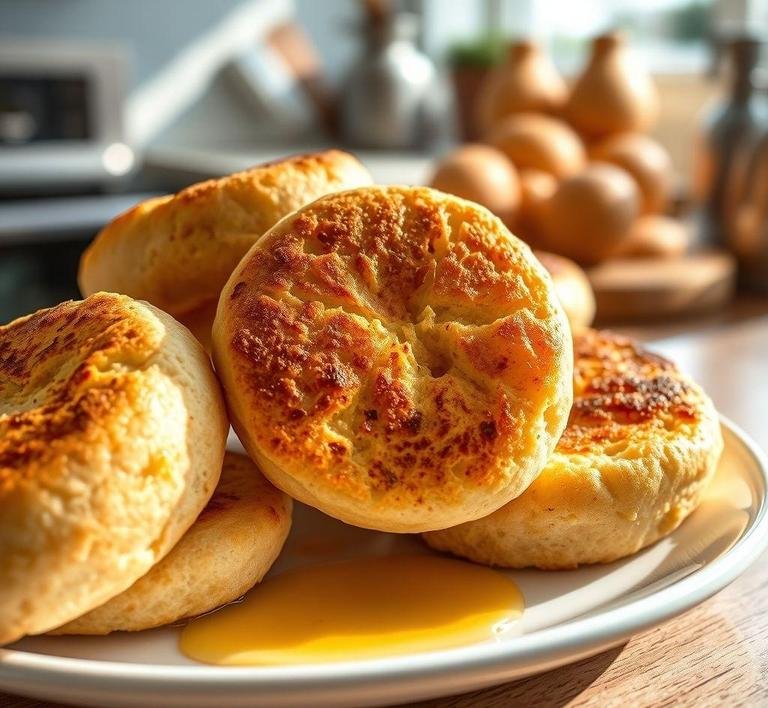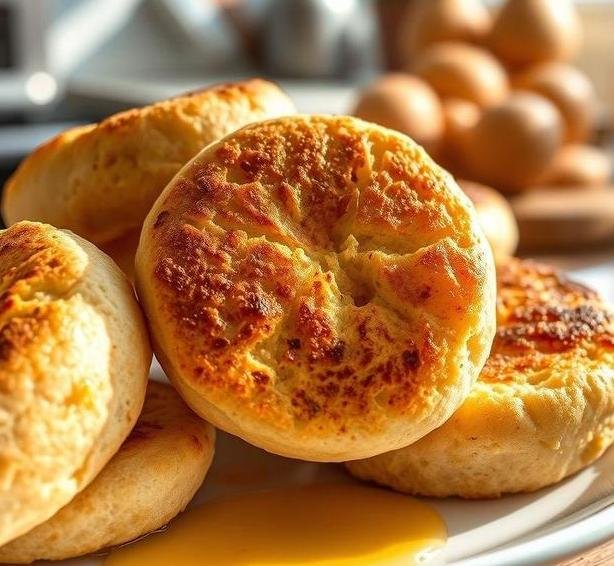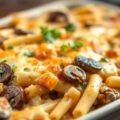Mary Berry, one of the UK’s most beloved chefs, is known for her timeless baking recipes, and her English Muffins are no exception. Unlike the American-style muffins, which are sweet and cake-like, English muffins are round, flat, and have a soft yet chewy texture, often enjoyed toasted and buttered. Mary Berry’s take on this classic breakfast item uses a simple approach with a focus on achieving that perfect balance of softness on the inside and a crispy golden crust on the outside.
These muffins are unique in that they are traditionally cooked on a griddle or in a heavy skillet rather than baked in an oven, which is a key feature that sets them apart from other baked goods. The result is a perfectly puffed, slightly spongy muffin that has tiny air pockets inside, making them ideal for slathering with butter, jam, or even a poached egg.
Mary Berry’s recipe for English muffins doesn’t rely on complicated ingredients or techniques, making them perfect for both beginners and seasoned bakers alike. They are an excellent choice for breakfast or brunch, and you can even use them to make hearty sandwiches for a more substantial meal.
Mary Berry’s English Muffins Recipe
Ingredients Needed

To make Mary Berry’s English Muffins, you’ll need the following basic ingredients:
- Strong white bread flour (500g) – This type of flour gives the muffins their structure and slightly chewy texture. The high protein content in bread flour helps develop gluten, making the muffins rise and become light and airy.
- Instant yeast (7g) – Yeast is the magic that makes these muffins rise. Instant yeast is a great choice because it doesn’t need to be activated with water beforehand, and it works quickly.
- Salt (10g) – Salt enhances the flavor of the muffins and helps regulate the yeast’s activity during fermentation, ensuring the dough rises evenly.
- Caster sugar (10g) – A small amount of sugar feeds the yeast and encourages it to activate, helping the muffins rise and gain flavor.
- Milk (250ml) – Milk adds moisture to the dough, making it soft and tender. The fat content in milk also contributes to the richness of the muffins.
- Butter (25g) – Butter gives the muffins a subtle richness and contributes to their soft texture.
- Water (125ml) – A bit of water is used to hydrate the dough and create the perfect consistency.
- Semolina flour (for dusting) – This is optional but highly recommended. Semolina flour is often used in baking to create a slightly rough texture on the outside of the muffins, preventing them from sticking and giving them that signature golden finish.
These ingredients work harmoniously to create a dough that’s rich, airy, and light – the perfect base for an English muffin.
Equipment Needed
Making Mary Berry’s English Muffins requires minimal specialized equipment, but there are a few tools that will make the process smoother and more efficient:
- Large mixing bowl – For mixing the dough ingredients.
- Wooden spoon or dough scraper – For combining the dough without overworking it.
- Measuring spoons and cups – Accurate measurements are crucial for baking, so these will ensure you get the right quantities of ingredients.
- Rolling pin – To roll the dough to the right thickness before cutting out the muffins.
- Cookie cutter or round cutter (about 7-8 cm) – To cut out the individual muffins. You can also use a glass or any other round object of similar size.
- Griddle or heavy-based frying pan – The traditional method of cooking English muffins is on a griddle or a flat pan, which ensures even heat distribution and creates that perfect golden-brown exterior.
- Tea towel – To cover the muffins while they rise and keep them warm once cooked.
Instructions To Make Mary Berry’s English Muffins
1. Prepare The Dough
Start by placing the bread flour, yeast, sugar, and salt into a large mixing bowl. Give it a quick stir to combine the dry ingredients. Then, melt the butter and add it to the warm milk (not hot, as this could kill the yeast). Pour this liquid mixture into the dry ingredients along with the water.
Using a wooden spoon, stir the mixture until it forms a sticky dough. If the dough feels too wet, you can add a little more flour, but avoid adding too much. The dough should be slightly tacky but manageable.
2. Knead The Dough
Turn the dough out onto a floured surface and knead it for about 10 minutes, or until it becomes smooth and elastic. You can use a dough scraper to help with the kneading process if necessary.
3. Let It Rise
Once kneaded, place the dough back into the bowl, cover it with a tea towel, and let it rise in a warm place for about 1 to 1.5 hours, or until it has doubled in size. This is when the yeast will work its magic and give the dough its light, airy texture.
4. Roll And Cut
Once the dough has risen, turn it out onto a lightly floured surface and gently roll it out to about 2 cm thick. Use a round cutter to cut out your muffins. Gently transfer them onto a baking sheet or a surface dusted with semolina flour.
5. Second Rise
Cover the cut muffins with a tea towel and let them rise again for 30-45 minutes. This second rise allows them to puff up even more, ensuring they’re light and soft.
6. Cook The Muffins
Heat a griddle or heavy-based frying pan over a low-medium heat. Lightly grease it with a little butter or oil. Carefully place the muffins onto the pan, ensuring there’s enough space between each one. Cook them for 6-8 minutes on each side, or until they’re golden brown and have a nice crust. Be sure to keep the heat low to avoid burning the outside while the inside cooks through.
7. Cool And Serve
Once cooked, let the muffins cool on a wire rack for a few minutes. When ready to serve, slice them open, toast them lightly, and butter generously. Add your favorite toppings like jam, honey, or a fried egg for a true indulgent treat!
Tips And Tricks
- Don’t Rush the Rising Process: Allow the dough to rise for the full time indicated in the recipe. This is crucial for developing the texture and flavor of the muffins. Rushing this step can result in dense, under-risen muffins.
- Maintain Low Heat on the Griddle: Cooking the muffins at too high a temperature can lead to them being overcooked on the outside but raw inside. Use a medium-low heat to ensure even cooking.
- Experiment with Fillings: Once you’ve mastered the basic recipe, you can experiment by adding ingredients like cheese, herbs, or even cooked bacon into the dough before the first rise.
- Use Semolina for an Authentic Finish: The semolina flour helps create that distinct English muffin texture on the outside. It’s a small detail that makes a big difference in the final product.
- Make a Batch for the Freezer: English muffins freeze very well. Simply slice them before freezing, so you can pop them straight into the toaster when you’re ready to eat.
Mary Berry’s English Muffins are a delightful breakfast treat that’s simple to make, yet yields a wonderfully satisfying result. Whether you’re enjoying them fresh from the griddle with a dollop of butter or toasting them with your favorite jam, these muffins will quickly become a household favorite. By following Mary Berry’s easy-to-understand method, you’ll create light, soft, and perfectly golden muffins every time. Don’t forget to take your time with the rising process, as that’s where the magic happens, ensuring you get a muffin with that airy, slightly chewy texture we all love. Happy baking!
Easy Recipe Variations For Mary Berry’s English Muffins

Mary Berry’s English muffin recipe is a classic and a staple in many kitchens, beloved for its soft, light texture and subtly tangy flavor. However, the beauty of English muffins lies in their versatility, and you can easily tweak the basic recipe to suit your taste preferences or dietary needs. Whether you’re looking to experiment with flavors, introduce different textures, or cater to specific dietary restrictions, there are plenty of easy variations to consider.
- Whole Wheat English Muffins: For a heartier, more nutritious muffin, substitute half or all of the white flour with whole wheat flour. This gives the muffins a nutty, earthy flavor and boosts the fiber content. Whole wheat flour tends to absorb more moisture, so you may need to slightly adjust the liquid amounts. The result is a slightly denser muffin with a deeper flavor, which pairs wonderfully with savory toppings like scrambled eggs or cheese.
- Cheese and Herb Muffins: Elevate the taste of your English muffins by adding finely chopped fresh herbs and grated cheese. Herbs such as rosemary, thyme, or parsley work particularly well. As for the cheese, a sharp cheddar or even some mozzarella can bring a delightful richness. These savory muffins are perfect for serving with soups or as a base for a breakfast sandwich.
- Cinnamon and Raisin Muffins: A sweet variation that adds a warming, aromatic element to your breakfast. Simply add ground cinnamon and a handful of raisins to the dough. You can also add a touch of nutmeg or allspice for additional depth. These sweet muffins are delicious when toasted with a smear of butter or jam and make a comforting start to your day.
- Gluten-Free English Muffins: For those who follow a gluten-free diet, you can swap the regular flour for a high-quality gluten-free flour blend. It’s best to use a flour blend that contains xanthan gum or guar gum, which help the muffins rise and retain their soft texture. This variation may require a little experimentation with the hydration levels, but it yields muffins that are just as light and fluffy as their gluten-containing counterparts.
- Fruit-Infused Muffins: To make your English muffins more vibrant and flavorful, try incorporating different fruits. Fresh blueberries, cranberries, or even mashed bananas can be added to the dough. This variation adds sweetness and color, making the muffins perfect for a brunch spread or a grab-and-go breakfast. Keep in mind that wet fruits like mashed banana might alter the dough’s consistency, so you may need to adjust the flour to compensate.
- Vegan English Muffins: For a vegan version of Mary Berry’s English muffins, you can swap the butter for vegan butter or olive oil and replace the eggs with a flax egg (1 tablespoon of ground flaxseeds mixed with 3 tablespoons of water, let sit for 5 minutes to thicken). A plant-based milk such as almond milk or oat milk works perfectly in place of regular milk. These muffins will still have the signature light texture and flavor, but with plant-based ingredients.
- Spicy Muffins: For a fun twist, try adding a pinch of chili flakes, cayenne pepper, or finely chopped jalapeños to the dough. This spicy variation brings an exciting kick, perfect for pairing with avocado, scrambled eggs, or cheese. A dollop of sour cream or cream cheese balances the heat, making these muffins a thrilling addition to your brunch table.
- Sourdough English Muffins: If you’re a fan of sourdough, you can introduce a sourdough starter into your English muffin dough. This variation gives the muffins a slight tang, more complex flavor, and a chewy texture that is characteristic of sourdough bread. Sourdough muffins are particularly good with butter, jam, or even as a base for eggs Benedict.
Storing Leftovers
While Mary Berry’s English muffins are usually best enjoyed fresh out of the oven, sometimes you may have leftovers, and that’s not necessarily a bad thing! These muffins are easy to store and can last for several days if kept properly. Here are some storage tips to ensure they remain fresh and tasty:
- Room Temperature Storage: If you plan to eat the muffins within a couple of days, you can store them at room temperature. Place them in an airtight container or a resealable plastic bag to keep them soft and prevent them from drying out. Make sure the muffins have cooled completely before storing them to prevent moisture buildup, which can lead to sogginess or mold.
- Freezing Leftovers: For longer storage, English muffins freeze exceptionally well. Once cooled, wrap each muffin tightly in plastic wrap or foil, and then place them in a freezer-safe bag or container. This helps preserve their freshness for up to 3 months. When you’re ready to eat them, simply remove the muffins from the freezer and allow them to thaw at room temperature, or pop them into the toaster to warm them up. They’ll come out nearly as good as fresh-baked.
- Reheating: Whether you’re reheating a stored muffin from the fridge or freezer, the best method is to toast it. Toasting brings back that crispy exterior while warming the inside, providing the perfect texture that English muffins are known for. If you prefer, you can also warm them in the oven by wrapping them in foil and baking at a low temperature (around 300°F) for 10-15 minutes. Just be sure not to overheat them to avoid drying them out.
What To Eat With Mary Berry’s English Muffins?
The humble English muffin is the perfect blank canvas for all sorts of toppings and fillings. From savory to sweet, it can be paired with a variety of foods to create an irresistible meal. Let’s explore a few ideas:
- Classic Breakfast Toppings: For a traditional English breakfast, serve your muffins with a dollop of butter and a drizzle of honey. You can also add a spoonful of your favorite jam or marmalade for a burst of sweetness. A fried egg on top, with crispy bacon or sausages on the side, makes for a hearty and satisfying breakfast.
- Eggs Benedict: English muffins are the quintessential base for eggs Benedict. Split the muffins in half, toast them lightly, and top with a poached egg and rich, creamy hollandaise sauce. Add some crispy bacon or smoked salmon for an indulgent twist on this classic dish.
- Avocado Toast: For a more modern breakfast, spread mashed avocado on your toasted muffins. Top with a sprinkle of salt, pepper, and chili flakes for a little heat, and perhaps a drizzle of olive oil or a squeeze of lemon. For extra protein, add a poached or fried egg on top.
- Sandwiches: English muffins can also serve as an excellent base for sandwiches. Use them for a simple ham and cheese melt, or get creative with fillings like chicken salad, roast beef, or even grilled vegetables. The texture of the muffin offers a sturdy, flavorful contrast to the fillings.
- Sweet Pairings: For a more indulgent treat, consider a dessert-style topping. Nutella, peanut butter, or almond butter spread generously on a warm muffin is an easy yet satisfying option. You could also top it with fresh fruit like strawberries, bananas, or blueberries, and a dusting of powdered sugar.
- Soup Sides: English muffins also make an excellent side dish to accompany soups, especially hearty ones like tomato soup, butternut squash soup, or a creamy mushroom soup. The muffins can be used to dip into the soup, absorbing the flavors while adding a delightful texture.
Conclusion
Mary Berry’s English muffins are a fantastic addition to your baking repertoire, offering a delicate balance of soft, airy texture and slightly tangy flavor. Whether you stick to the classic recipe or explore some fun variations, you’re guaranteed a delicious result. With the right storage methods, these muffins can be enjoyed over several days, making them a convenient option for busy mornings. And when it comes to pairing them, the possibilities are endless-whether you prefer savory toppings like eggs and bacon or sweet options like fruit and jam, these muffins can adapt to any occasion. So go ahead, try out different variations, get creative with your toppings, and savor the delightful versatility of Mary Berry’s English muffins.
FAQs
What Are The Key Ingredients In Mary Berry’s English Muffins Recipe?
Mary Berry’s English muffins recipe typically requires flour, yeast, milk, butter, sugar, and a pinch of salt. It also calls for baking powder and a bit of water to help create the right texture. These ingredients combine to form a light and fluffy muffin with a slightly crisp exterior.
How Do You Achieve The Signature Texture Of Mary Berry’s English Muffins?
To achieve the classic texture of Mary Berry’s English muffins, it’s important to properly proof the dough. After mixing the ingredients, allow the dough to rise until doubled in size. Then, roll it out to the correct thickness, and cook the muffins slowly over a low heat to ensure they cook evenly on the inside without burning on the outside. Using a heavy-based frying pan or griddle is ideal for this.
Can I Make Mary Berry’s English Muffins Ahead Of Time And Freeze Them?
Yes, Mary Berry’s English muffins can be made ahead and frozen. After baking, allow the muffins to cool completely. Then, wrap them tightly in plastic wrap or place them in an airtight container before freezing. When ready to eat, simply toast them straight from the freezer for a warm, freshly-baked texture.


